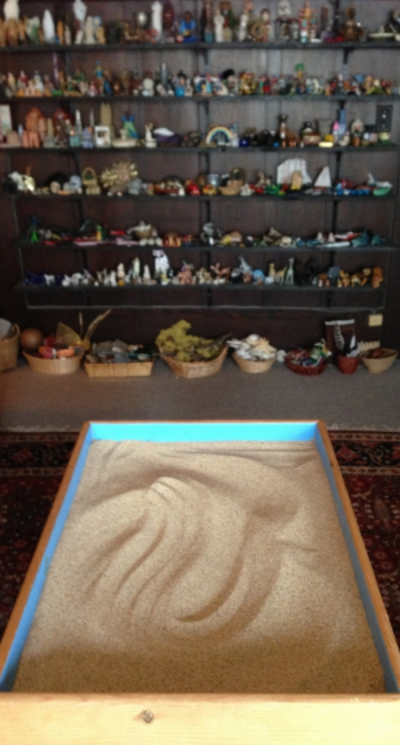What is Sandplay Therapy?
What is Sandplay Therapy?
Sandplay is a powerful method for accessing the unconscious in a way that brings about profound change. It is a safe, gentle, effective evidence-based method that accelerates and deepens healing for many issues, including anxiety, depression, grief, death and dying, trauma and personal growth.
Research results for sandplay are similar, or in some cases startlingly better than, other modalities of psychotherapy, as good as or better than for CBT (Freedle, 2022).
Studies have covered the use of sandplay therapy in many different life conditions: refugees, sexual abuse, substance abuse, addiction to smart phones, children of divorce, visual and other disabilities. Studies address a wide range of diagnoses: anxiety, PTSD, OCD, depression, ADHD, behavior problems, grief, aggression and low self-esteem, poverty and dysfunction. Neuroimaging studies show the positive effects of sandplay therapy on cortical and subcortical brain functioning. Approximately half of this research was with group sandplay in various forms. Improvement can be seen in 10 sessions (Freedle, Journal of Sandplay Therapy 2022).
Sandplay therapy is based on the work of Dora Kalff and C. G. Jung. Inherent in sandplay is the idea that the psyche, given the right conditions, is self-healing. In these trainings, therapists learn the nuances of Jungian Depth Psychotherapy, how to understand the images that arise from the unconscious, and how to provide "the right conditions" for healing.
These courses are designed for therapists who want to begin using sandplay in their practices with adults and/or children. Therapists working in verbal modalities and/or expressive arts therapies may find this a useful addition to their repertoire.
Sandplay Therapy FAQ
Many beginning sandplay therapists have questions about the basics of how to prepare for and introduce sandplay to clients. Here are some of the most frequently asked questions and their answers, based on my experience of training beginning sandplay therapists over the years.
If you have other questions, feel free to email me at linda@sandplaytrainingworldwide.com.
For sandplay trainings, see www.SandplayTrainingWorldwide.com.
1. How should I introduce sandplay to clients?
Children usually need no introduction to sandplay therapy. They see they tray and the figures, and they begin to work in the sand. With adult clients, I usually wait until they inquire about the sandplay collection or the sandtray. I should qualify my answer by saying that I do long-term, in-depth work with clients, and I rarely use sandplay within the first year of therapy. I like to have a solid relationship with clients before introducing sandplay. That said, if a client asks about sandplay, and seems interested and asks to do it, then I invite them to use the tray, often saying, "Make whatever you like in the sand."
2. How can I integrate sandplay into my practice?
Sandplay is a powerful addition to verbal therapy, and provides access to unconscious material in a visual yet visceral way. Once sandplay has been introduced to a client, sometimes I suggest, “Would you like to make a sandtray today?” or a classic question, “Shall we see what your hands have to say about this?” It may be helpful to introduce sandplay when clients are at a loss for words, when they feel stuck, when they’ve had a powerful dream they’d like to better understand, or simply when they feel like playing. Play is serious work!
3. Are there situations where I should not use sandplay?
First and foremost, never push with sandplay. If a client seems uninterested, let it be. Some clients, in an effort to please us, will say yes to our suggestion to use sandplay, but then never get around to it, and perhaps even sit in front of the tray and continue to talk, never touching the sand. Again, let it be. I believe that clients’ defenses protect them from entering places they are not yet ready to experience. Sandplay is very deep work, and accesses parts of the psyche that are not normally accessible. Great care must be taken on the part of the therapist, and great patience. When we are beginners at sandplay, we may be eager to use it with everyone. Caution, discernment and patience are required.
4. Can sandplay be helpful with all of my clients?
No. Sandplay is not for everyone. Some child clients would prefer to do play therapy and do not seem interested in the sand. Some adult clients will never use sandplay, and will in fact shrink from the very idea of “playing with toys.” Sandplay removes the verbal defenses, and can leave clients feeling very exposed. Many verbally articulate clients intuit this, and steer away from sandplay. I believe it is very important for the therapist to respect this. The introductory course in sandplay offers gradual ways of getting adult clients comfortable with the sand.
5. Does sandplay really work?
Yes, in my experience, it reaches deeper levels of healing, and this complements and deepens the verbal work in counseling. It is the experience of working in the sandtray that heals.
6. What is the difference between “Kalffian theory” and other more interactive kinds of sandplay?
Way back in the beginnings of sandplay, Dora Kalff and Margaret Lowenfeld agreed that Kalff would take the name “sandplay” for her method, and Lowenfeld and all others would use the term “sandtray.” The Kalffians seem to be the most strict about use of these terms. As I’ve experienced it, the Kalffians seem to value maternal holding of the sacred space of therapy, as well as the therapist’s presence. Verbal interpretation is withheld, so as not to interrupt the creative process, until a year or more after therapy is completed. Sandtray therapists, on the other hand, tend to be more interactive, using forms of active imagination or gestalt type interaction, or even immediate verbal interpretation with the tray. This is particularly effective in work with families and couples. (Traditional Kalffians work with individuals, and not with families or couples.)
7. Is it really effective to use sandplay without the therapist’s interpreting the image in the tray to the client?
Yes, I have found it very effective in healing preverbal or nonverbal trauma. There is a magical moment that happens when the client plays out trauma in the tray, and the therapist viscerally and emotionally resonates with it, “getting it” in a way that might not be possible with words. This experience for the therapist then informs her work in the verbal part of therapy. Interpretation, by definition, makes the unconscious conscious. Any interpretation may be experienced as criticism, thereby interfering with the free and protected space. Many beginning students of sandplay have a difficult time grasping the importance of delayed interpretation, but after seeing some sandplay cases, usually begin to understand the power of delayed interpretation in giving the client the freedom to make in the sand whatever the unconscious may bring,, without censoring themselves.
8. How will I know if sandplay is “working” with a client. How will I know if it’s effective?
Patiience is required in depth psychotherapies such as sandplay. We need to cultivate the ability to be comfortable with “not knowing,” and to have faith in the healing process based in our own healing experiences in psychotherapy and also with our own sandplay work as clients. Over time, and with training, you will be able to see healing taking place as the images in the sandtray develop and change. And you will see new attitudes and ways of being in your clients.
9. Should I do my own sandplay process, or be in my own psychotherapy?
Absolutely. In my opinion, it is unethical for any therapist to practice a form of psychotherapy that they have not experienced as a client. Our foundation of faith in the healing process is based in our own experiences of our own healing. It's also very important to have the deep, psychospiritual experience of sandplay yourself.
10. Can I learn to do sandplay in a weekend workshop, or at a conference?
Yes! You can begin to learn sandplay through workshops, trainings and by doing your own personal sandplay process. Sandplay Training Worldwide is Dr. Linda Cunningham’s training program for professional sandplay therapists, providing intensive three-day and one- or two-week programs, as well as related offerings.
Just one example of a student's work in the sand. Used with permission.


